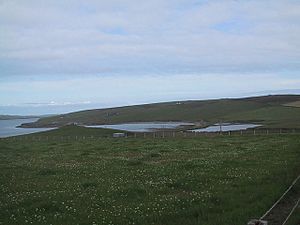Thorfinn Torf-Einarsson facts for kids
Quick facts for kids
Thorfinn Torf-Einarsson
|
|
|---|---|
| Earl of Orkney | |
| Title held | ? to 963 |
| Predecessor | Torf-Einarr |
| Successor | Arnfinn Thorfinnsson |
| Native name | Þorfinnr hausakljúfr - Thorfinn Skull-splitter |
| Died | c. 963 |
| Buried | Hoxa, Orkney |
| Noble family | Norse Earls of Orkney |
| Spouse(s) | Grelad |
| Issue | Arnfinn, Havard, Hlodvir, Ljot, Skuli and 2 daughters |
| Father | Torf-Einarr Rognvaldsson |
| Mother | Unknown |
Thorfinn Torf-Einarsson, also known as Thorfinn Skull-splitter, was a powerful leader in the 900s. He was an Earl of Orkney, which meant he ruled the Orkney Islands. His nickname, Skull-splitter, comes from the Old Norse language. We learn about Thorfinn from old stories like the Orkneyinga saga and St Olaf's Saga. These stories were written down in Iceland around the 1200s. It can be hard to know if all the details in them are completely true.
Contents
Thorfinn's Family and Early Life
Thorfinn was the youngest son of Torf-Einarr. Torf-Einarr was also an Earl of Orkney. Thorfinn's grandfather was Rognvald Eysteinsson, the very first Earl of Orkney.
Thorfinn had two older brothers, Arnkel and Erlend. Sadly, they died in a war in England. This happened at the same time as Erik Bloodaxe died. Erik's wife, Gunnhildr, then came to Orkney with her sons. They used the islands as a base for their summer raiding trips.
Thorfinn had five sons with his wife, Grelad: Arnfinn, Havard, Hlodvir, Ljot, and Skuli. Grelad's father was "Earl Dungad of Caithness." This marriage was important because it helped Thorfinn's family gain more power in northern Scotland. Thorfinn and Grelad also had two daughters. Each daughter had a son named Einar. One was called Einar kliningr ("Buttered-bread") and the other Einar harðkjotr ("Hard-mouth").
Later, Gunnhildr and her family left Orkney for Norway. Before they left, they arranged for their daughter, Ragnhild Eriksdotter, to marry Thorfinn's son, Arnfinn. After a while, Erik Bloodaxe's sons returned to Orkney. They caused a lot of trouble on the islands.
Thorfinn's Death and What Happened Next
Thorfinn Torf-Einarsson lived to be an old man. He likely died around the year 963 from an illness. People believe he was buried at a place called Howe of Hoxa on South Ronaldsay.
After Thorfinn died, his sons became Earls. However, there was a lot of fighting among them for control of the earldom.
Ragnhild, Arnfinn's wife, arranged for Arnfinn to be killed in Caithness. She then married his brother, Havard. Havard ruled as earl for a while. But Ragnhild was not happy. She worked with her nephew, Einar kliningr, who then killed Havard.
Einar and Ragnhild then had a disagreement. Ragnhild convinced Einar harðkjotr to attack and kill his cousin, Einar kliningr. Ragnhild's plans continued. She then married Ljot Thorfinnson, who then had the second Einar killed. After marrying three of Thorfinn's sons, Ragnhild is not mentioned again in the stories. Ljot became earl and was known as a great leader.
Skuli, another of Thorfinn's sons, tried to become Earl of Orkney with the help of the Scottish king. But he never gained control of the islands. He was killed in a battle against Ljot in Caithness. Ljot then took control of Caithness. This made the Scots angry. MacBeth, a powerful Scottish leader, brought a large army north. They fought a battle near Wick. Even though Ljot's army was smaller, he won the battle. However, Ljot later died from his battle wounds. People thought his death was a great loss.
Hlodvir then became earl and ruled Orkney well. He married Eithne, the daughter of the King of Ireland. Hlodvir died peacefully and was buried at Ham in Caithness. His son, Sigurd, became the next earl.
Today, a modern beer from Orkney called Skull Splitter is named after Thorfinn.
See also
- Battle of Stainmore - This is where Erik Bloodaxe was killed.
- Stone Lud, a stone said to mark the grave of Ljot Thorfinnson.
Images for kids
-
The old watermill and mill pond at Ham, Caithness.



